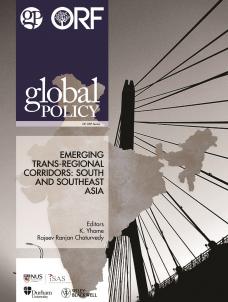
Part of the GP-ORF series, this volume looks at four specific proposed and/or planned projects of trans-regional economic corridors connecting South Asia and Southeast Asia, and through them to other regions.
Asia’s rise on the global economic map has necessitated greater interconnection within, and with, the outside world. This development of interconnection is taking place between nations as well as across regions and sub-regions in Asia. The concept ‘economic corridor’ is used to explain this phenomenon. Economic corridors link economic agents within a country or across regions by providing connection between economic nodes or hubs where economic resources and actors are concentrated. Economic corridors are seen as a “catalyst for regional integration” and a “driver for inclusive growth” by bringing in lagging regions into the growth process. They also provide “spatial focus” for regional cooperation initiatives by facilitating priorities of regional projects as well as access to global production chains. The basic emphasis that lies in the creation of economic corridors is to ensure that within a contiguous area, there is potential to attract investments and generate economic activity.
Edited by K. Yhome and Rajeev Ranjan Chaturvedy, the volume looks at four specific proposed and/or planned projects of trans-regional economic corridors connecting South Asia and Southeast Asia, and through them to other regions. The proposed Indo-Pacific Economic Corridor will connect the Indian and the Pacific Oceans through South and Southeast Asian littorals. China’s Maritime Silk Road initiative plans to link East Asia to Africa and Europe through South and Southeast Asia. The four-nation Bangladesh, China, India and Myanmar Economic Corridor plans to connect China’s southwest region to India’s eastern region through Bangladesh and Myanmar. Lastly, the Trans-Himalayan Economic Corridor will link South and Southeast Asia to Central Asia through Nepal. While economic corridors are of course judged on their economic merit, there are also strategic and security issues associated with these corridors, as is evident from the papers in this volume.
To download the free e-book please click here (MOBI and Epub versions). Or for PDF versions of GP-ORF series publications please click here.
Contents
Introduction
Emerging Trans-Regional Corridors: Perspectives from South and Southeast Asia
K. Yhome and Rajeev Ranjan Chaturvedy
Linking South and Southeast Asia
Connecting South Asia with Southeast Asia: A Reality Check
Tariq A. Karim
India: The Bridge Linking South and Southeast Asia
Sreeradha Datta
Projects, Proposals and Plans
Indo-Pacific Economic Corridor: A Vision in Progress
Shankari Sundararaman
The 21st Century Maritime Silk Road
Rajeev Ranjan Chaturvedy
The BCIM Economic Corridor: Prospects and Challenges
K. Yhome
Trans-Himalayan Economic Corridor: Nepal as a Gateway
Madhukar S.J.B. Rana
Economic and Security Imperatives
The MSR Economic Corridor: Character and Implications
Amitendu Palit
China’s MSR: A Strategic View from India
Darshana M. Baruah
China, ASEAN and the MSR: A Southeast Asian Perspective
Martin A. Sebastian
Citation: Yhome, K. and Chaturvedy, R. R. 2017. Emerging Trans-Regional Corridors: South and Southeast Asia. London: Global Policy and Observer Research Foundation.